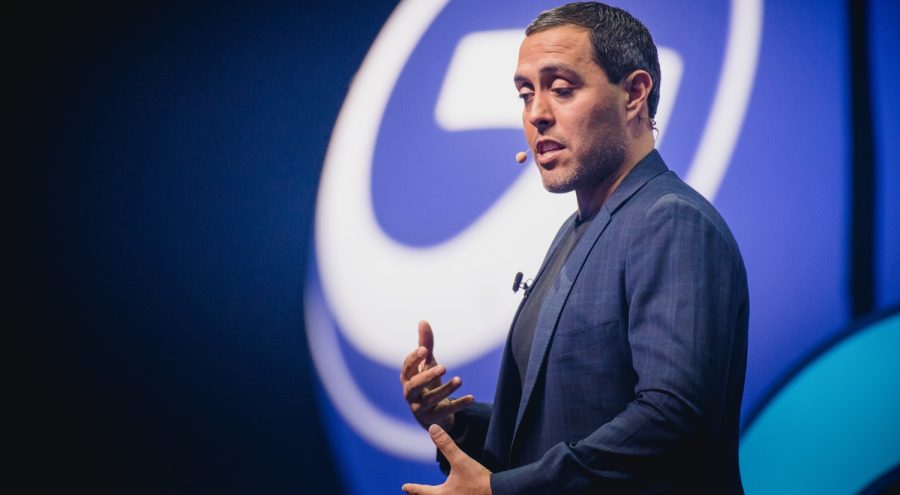Jairek Robbins’ last name is famous; his first name, not so much. Jairek, he says, is the result of creative parents, dad Tony Robbins and mom Liz Acosta. They originally planned to name him Josh, but when he entered the world, he didn’t look like a Josh. He remained unnamed for three days before his parents settled on Jairek.
One day when he was in elementary school, he came home upset. The other kids had looked up their names and were discussing what they meant. All the kids found their names and the meaning behind them, but if you went to the J pages, there was James, Jason, John and Jonathan… no Jairek.
He had to know: What did Jairek mean? As he would later do in his career as a coach, speaker and author, Robbins set out to find the facts. Now he has great command of them. His motto is “learn it, live it, give it,” because knowing something of value is pointless if you don’t also practice it and share it. Back then, he just wanted to learn where Jairek came from.
He went right to the source.
J is for joy, his mom told him. A-I-R is to remember to breathe. E is for earth and K is for king. A wide grin spread across his face as he wondered aloud if she made it up on the spot. Regardless, he returned to school armed with his research. “Here is the meaning and purpose behind my name,” he told his classmates.

The search for meaning and purpose—and more importantly, the sharing of what he finds—has defined his life since then. It has taken him from volunteering in a village in Uganda to hard labor in a lumberyard in Canada to coaching executives around the world. And now, he sees the culmination of his life’s work in his new role: president of SUCCESS Enterprises, which includes SUCCESS magazine, SUCCESS.com, SUCCESS Coaching, Achievers All-Access and other properties.
He says, “everything I’ve done my entire life” prepared him for the job. “The network I have, the experience I have, all the study and research I’ve done, all the skill sets I’ve built for 17 years, every single one of the stars literally aligned for this.”
His course, “The Complete Guide to Activating High Performance,” created with Shawn Stevenson and Ben Greenfield, has more than 7,300 members in 120-plus countries and has been translated into more than 30 languages.
He sees his new job at SUCCESS as the thesis of a Ph.D. candidate after years of studying. His primary task will be building SUCCESS’ coaching platform.
He says a major emphasis will be “performance coaching,” which centers on human performance and business growth. “This will be a massive part of our focus to getting clients to be their best so they can give their best and grow their business,” he says.
The expansion of SUCCESS’ coaching platform comes at an opportune time; coaching is having a moment across the entire business (and life) landscape. Robbins is on a mission to help clients craft the success they desire and deserve in their life and business.

In his book Live it! Achieve Success by Living with Purpose and in his coaching and speaking, Robbins talks often about major and minor roadblocks and how some people over-focus on the minors to their own detriment. Most of his clients are highly successful in their careers, but Robbins sees the same three problems over and over again: heart attacks, divorces and bankruptcies, all of which are often the result of paying scant attention to the majors. His teaching shows them how to build systems into their lives to avoid these problems or learn to work through them.
He traces his passion for helping people focus on the most important things to his father, who learned it from Jim Rohn, a towering legend in the personal development industry. SUCCESS owns much of the late icon’s intellectual property.
One method Robbins uses is to ask clients to think deeply about their vision of a perfect day and then build their careers around achieving it, as opposed to launching a career and trying to shoehorn an idealized life around that.
“The gift of COVID,” and he uses the word “gift” carefully, even reluctantly, “is we’ve been given a chance to ask ourselves important questions about our lives: Do I really love it? Is it really in alignment with who I am and how I want to live my life?”
For many people, the answer to those questions is no. If we are ever going to take a big swing at life, whether we’re a solopreneur or a new leader, now is the time. But we need help. Robbins is passionate about building a team and platform to provide it.
“What we’re experiencing as a globe is a transitionary moment, where things used to be a certain way and now there’s a new way,” Robbins says. “Coaching is critical in transitionary moments. We get to shake the snow globe, shake everything up. And we get to decide how we want it to land back down. We get to decide what boundaries or frameworks to put in place that allow us to make it the way we want it as the dust settles back down. So since the whole world is shaken up in this moment, a great coach asks questions like, ‘If you could have it all your way and you could design a perfect day, what would it look like? Where would you wake up? Who would be there? How would you feel? What would you do?’
“Because all the dust is still flying, there is a chance you can recraft your day exactly how you want it before the dust settles and we get locked back into just what is. It’s a huge opportunity.”
* * *
The first time Robbins was supposed to fly, he didn’t. Just a young boy, he sat down in his seat, got scared and ran off the plane. Ten years later, he again left a plane early… by jumping out of it, two days in a row. He has since chased adventure around the world. He’s not suggesting his clients become adrenaline junkies, but he does want them to push the bounds of their comfort zones.
To illustrate his point, he took control of the screen during our Zoom interview and sketched a circle inside a square. The circle represented a comfort zone, and the square represented the breaking zone—the point at which discomfort becomes disabling. In between was the growth zone. That’s where he wants to take his clients.
“Part of the coaching process is: How do we push people outside the comfort zone but not to the breaking zone?” he asks. “How do we dance in that growth zone for them to have experiences to expand what’s possible in their world without completely locking them up?”
Whatever an individual’s comfort zone, the challenge for Robbins as he builds out SUCCESS’ coaching business is the same: “How do we get to the person who needs us the most, at the moment they need us the most, with the message they need the most?”
* * *
As a young man, Robbins spent several months in a rural village in Uganda as a volunteer. In Live it!, he describes sleeping each night in an old schoolhouse with no running water or electricity.
He woke up every morning to watch the sun rise. Just outside his door was a clinic. Every day, an older man swept leaves off the dirt path that led to the clinic. He was like a metronome, sweeping at the same time and with the same motion, first in one direction and then in the other. Robbins marveled at the man’s consistency and joy.
“When he was finished, the look on his face showed pride, satisfaction and certainty that the task he just completed mattered,” Robbins writes. “It was the look you see on a person’s face when they are doing what they were put on this planet to do.”
It’s the look that he wants to see on the faces of his coaching clients; it’s the look on his own face as he talks about his role at SUCCESS. But where did that look come from? Why did the man have it? For nearly three months, Robbins watched the man sweep every day. Using a translator, Robbins asked the man why he did it. “The reason I sweep the leaves,” the man said, “is I believe every human being, whether it be a small baby about to enter this world or a sick elderly person about to leave this world, deserves a clear path to do so.”
Years later, Robbins still thinks about that man, his answer and his passion whenever he encounters what seems to be drudgery equivalent to sweeping a sidewalk. “Wait a second,” he tells himself. “Pause. Remember the old man with the leaves.”
It’s a lesson he passes on to clients. “If I can’t learn to be present and enjoy the moment I’m in, regardless of if it’s what I wanted or didn’t want, the rest really doesn’t matter. But if I can find meaning and purpose in the moments, that’s a huge opportunity,” he says. “That’s where the magic is.”



